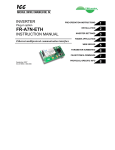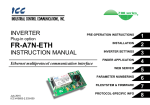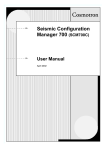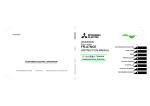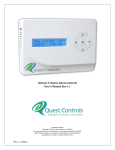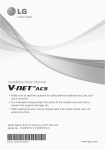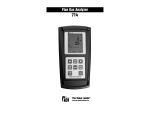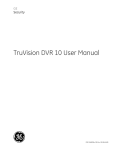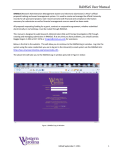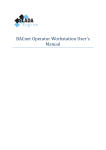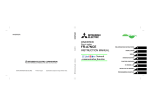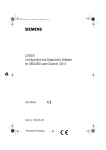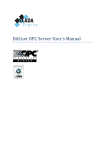Download FR-A7N-XLT V2.100 User`s Manual
Transcript
ICC INDUSTRIAL CONTROL COMMUNICATIONS, INC. INVERTER PRE-OPERATION INSTRUCTIONS 1 INSTALLATION 2 NETWORK CONNECTION 3 INVERTER SETTINGS 4 PROTOCOLS 5 TROUBLESHOOTING 6 SECTION 7 7 SECTION 8 8 Plug-in option FR-A7N-XLT INSTRUCTION MANUAL RS485 multiprotocol communication interface July 2008 ICC #10638-2.100-000 Thank you for choosing this ICC, Inc. plug-in option for the Mitsubishi 700 Series Inverter. This instruction manual provides handling information and precautions for use of this equipment. Incorrect handling may cause unexpected failures or damage. In order to ensure optimal performance, please read this manual carefully prior to use of the equipment. Please forward this manual to the end user of the equipment. This section pertains specifically to safety issues Do not attempt to install, operate, maintain or inspect this product until you have read through this instruction manual and any related documents carefully, and can use the equipment properly. Do not use this product until you have a full working knowledge of the equipment, safety information and instructions. In this instruction manual, the safety instruction levels are classified into "WARNING" and "CAUTION" levels. WARNING Assumes that incorrect handling may cause hazardous conditions resulting in death or severe injury. CAUTION Assumes that incorrect handling may cause hazardous conditions resulting in moderate or slight injury, or may cause physical damage only. CAUTION Please note that even the level may lead to serious consequence depending on conditions. Please be sure to follow the instructions of both levels as they are critical to personnel safety. SAFETY INSTRUCTIONS 1. Electrical Shock Prevention WARNING • Do not open the front cover of the inverter while power is on • • • • • • • or while the inverter is running, as an electrical shock may result. Do not operate the inverter with the front cover or wiring cover removed, as accidental contact with exposed high-voltage terminals and internal components may occur, resulting in an electrical shock. If power is off, do not remove the front cover except when necessary for wiring or periodic inspection. While the front cover is removed, accidental contact with exposed highvoltage terminals and internal components may occur, resulting in an electrical shock. Prior to starting wiring or inspection, confirm that input power to the inverter has been switched off via observation of the inverter’s display panel. Additionally, wait for at least 10 minutes after removal of input power, and then confirm that all residual voltage has been dissipated by using a voltage meter. Internal DC bus capacitors may contain high voltages for several minutes after removal of input power, resulting in a dangerous situation should anything come into contact with them. All personnel involved in the installation or inspection of this equipment should be fully competent to perform the required work. Always install plug-in options prior to wiring main power. Do not touch the plug-in option with wet hands. Do not subject the cables to scratches, excessive stress, heavy loads or pinching. A-1 2. Injury Prevention 3) Usage CAUTION • To prevent explosions or similar damage, apply only the voltages specified in the instruction manual to each terminal. • To prevent explosions or similar damage, ensure that all cables are properly connected to the correct terminals. • To prevent explosions or similar damage, observe all wiring polarity indicators. • To prevent burns from hot components, do not touch the inverter while power is on, or for some time after power is removed. 3. Additional Instructions Please note the following points to prevent equipment damage, injury or electrical shock. 1) Transportation and Mounting CAUTION • Do not install or operate the plug-in option if it is damaged or has parts missing. • Do not stand on or rest heavy objects on the equipment. • Check that the mounting orientation is correct. • Prevent conductive items such as screws and metal fragments, or flammable substances such as oil from entering the inverter. WARNING • Do not modify the equipment. • Do not remove any inverter or option parts unless specifically instructed to do so in this manual. CAUTION • Performing a “parameter clear” or “all parameter clear” will reset all inverter parameters to their factory default settings. After performing one of these operations, remember to reenter any custom parameter values prior to starting operation. • To prevent damage from electrostatic discharge, always touch a grounded piece of metal prior to touching any equipment. 4) Maintenance, Inspection and Parts Replacement CAUTION • Do not perform hi-pot tests on the equipment. 5) Disposal CAUTION • Contact the local or state environmental agency in your area for details on the disposal of electrical components and packaging. 2) Trial Run 5) General Instructions CAUTION • To prevent unexpected equipment movement, confirm and adjust all required parameters prior to starting operation. A-2 For clarity purposes, illustrations in this manual may be drawn with covers or safety guards removed. Ensure all covers and safety guards are properly installed prior to starting operation. − CONTENTS − 1 1.1 1.2 PRE-OPERATION INSTRUCTIONS 1 Product Overview ...................................................................................................................1 Unpacking and Product Confirmation..................................................................................2 1.2.1 Shipment Confirmation..................................................................................................................................2 1.2.2 Component Overview....................................................................................................................................3 1.3 1.4 1.5 2 2.1 2.2 2.3 LED Indicators ........................................................................................................................4 Status LED Error Codes.........................................................................................................5 Environmental Specifications ...............................................................................................6 INSTALLATION 7 Pre-Installation Instructions ..................................................................................................7 Installation Procedure ............................................................................................................8 DIP Switch Settings ..............................................................................................................11 2.3.1 2.3.2 2.3.3 2.3.4 Protocol Selection .......................................................................................................................................12 Baud Rate Selection....................................................................................................................................12 Parity & Stop Bits Selection ........................................................................................................................12 2-Wire / 4-Wire Selection ............................................................................................................................13 I 3 3.1 3.2 3.3 3.4 3.5 3.6 4 4.1 NETWORK CONNECTION Metasys N2 Connections .....................................................................................................14 Siemens FLN Connections ..................................................................................................15 BACnet MS/TP Connections................................................................................................16 Modbus RTU Connections...................................................................................................17 RS485 Port Electrical Interface ...........................................................................................20 Wiring.....................................................................................................................................21 INVERTER SETTINGS 22 RS-485 Communication Settings ........................................................................................23 4.1.1 4.1.2 4.1.3 4.1.4 4.1.5 4.1.6 4.2 14 RS-485 Communication Station (Pr. 331)...................................................................................................23 RS-485 Communication Speed (Pr. 332) ...................................................................................................24 RS-485 Communication Parity Check Selection (Pr. 334) .........................................................................24 Protocol Selection (Pr. 549) ........................................................................................................................25 Free Parameter 1 (Pr. 888) .........................................................................................................................25 Free Parameter 2 (Pr. 889) .........................................................................................................................26 Operation Mode Setting .......................................................................................................27 4.2.1 Operation Mode Indication ..........................................................................................................................27 4.2.2 Operation mode switching & comm. startup mode (Pr. 79, Pr. 340) ..........................................................28 4.3 4.4 II Operation & Speed Command Source (Pr.338, Pr.339, Pr.550) .......................................32 Communication EEPROM write selection (Pr. 342) ..........................................................36 5 5.1 PROTOCOLS Johnson Controls, Inc. Metasys N2....................................................................................37 5.1.1 5.1.2 5.1.3 5.1.4 5.2 Node Addressing.........................................................................................................................................44 Network Characteristics ..............................................................................................................................44 Supported Subpoints...................................................................................................................................45 Subpoint Details ..........................................................................................................................................48 BACnet MS/TP.......................................................................................................................57 5.3.1 5.3.2 5.3.3 5.3.4 5.4 Node Addressing.........................................................................................................................................37 Network Characteristics ..............................................................................................................................38 Object Summaries.......................................................................................................................................38 Supported Objects.......................................................................................................................................40 Siemens FLN .........................................................................................................................44 5.2.1 5.2.2 5.2.3 5.2.4 5.3 37 Station Addressing ......................................................................................................................................57 Network Characteristics ..............................................................................................................................57 Protocol Implementation Conformance Statement .....................................................................................57 Supported Objects.......................................................................................................................................64 Modbus RTU..........................................................................................................................69 5.4.1 5.4.2 5.4.3 5.4.4 5.4.5 Node Addressing.........................................................................................................................................69 Network Characteristics ..............................................................................................................................69 Supported Functions ...................................................................................................................................69 Register Addressing ....................................................................................................................................70 Coil & Discrete Input Mappings...................................................................................................................71 III 6 IV TROUBLESHOOTING 73 PRE-OPERATION INSTRUCTIONS 1 PRE-OPERATION INSTRUCTIONS 1.1 Product Overview The FR-A7N-XLT RS485 multiprotocol communication interface allows the 700-series inverter into which it is installed to communicate on networks using the following protocols: Johnson Controls, Inc. Metasys® N2 Siemens FLN BACnet MS/TP Modbus RTU The option card mounts directly onto the inverter’s control board, and communicates to the inverter via its built-in RS485 communication port, located in the upper-left hand corner of the inverter’s control board. Note that because the inverter’s RS485 port is used by the FR-A7N-XLT card, it is therefore unavailable for use by any other network when the FR-A7N-XLT interface is installed. Before using the option card, please familiarize yourself with the product and be sure to thoroughly read the instructions and precautions contained in this manual. In addition, please make sure that this instruction manual is delivered to the end user of the option card, and keep this instruction manual in a safe place for future reference or unit inspection. The FR-A7N-XLT can be connected to either 2-wire or 4-wire RS485 networks, selectable via DIP switch settings. Protocol selection, etc. is also configured via DIP switch settings, while the inverter’s network station address is configured via an inverter parameter setting. 1 1 PRE-OPERATION INSTRUCTIONS 1.2 Unpacking and Product Confirmation 1.2.1 Shipment Confirmation Check the enclosed items. Confirm that the correct quantity of each item was received, and that no damage occurred during shipment. 2 Plug-in option (P/N 10620A): qty. 1 RS485 cable (P/N 10621): qty. 1 Hex-head standoff (5.5mm): qty. 1 Mounting screws (M3 x 6mm): qty. 2 2 PRE-OPERATION INSTRUCTIONS 1.2.2 Component Overview 7 Network data TX/RX LEDs 8 Configuration DIP switches Status LED 1 Inverter RS485 terminal block Inverter data TX/RX LEDs Network RS485 terminal block Mounting hole Mounting hole Inverter connector (on back) 3 PRE-OPERATION INSTRUCTIONS 1.3 LED Indicators Status LED Network Data RX • In 4-wire mode, blinks when data is detected on the network. • In 2-wire mode, blinks when data is detected on the network, and when the option card transmits data on the network. Indicates various error conditions. Refer to section 1.4. Inverter Data RX Blinks when the option card receives data from the inverter 4 Network Data TX Inverter Data TX Blinks when the option card transmits data on the network Blinks when the option card transmits data to the inverter PRE-OPERATION INSTRUCTIONS 1.4 Status LED Error Codes The green “status” LED provides an indication of the option card’s health & configuration. Typically, this LED should be solid green, which indicates that the card has a valid configuration and that it is operating normally. If an invalid configuration or some other hardware error is detected, then the status LED will emit a sequence of short blinks. Each sequence of short blinks is terminated by 2s of continuous off time, after which the sequence repeats. The error code is indicated by counting the number of short blinks. Refer to the following table for a list of the possible error codes. Error Code 1 2 3 Explanation INVALID ADDRESS: an invalid network station address is entered in Pr. 889 Free parameter 2. Refer to section 4.1.6. INVALID PROTOCOL: an invalid protocol has been selected. Refer to section 2.3.1. RESOURCE ALLOCATION ERROR: an internal resource error has been detected. Contact ICC technical support for assistance. To clear the error, correct the cause of the error and cycle power to the inverter to reset the option card. 5 1 PRE-OPERATION INSTRUCTIONS 1.5 Environmental Specifications Item Operating Environment Operating Temperature Storage Temperature Relative Humidity Vibration Grounding Power supply Cooling Method Communication Speed Specification Indoors, less than 1000m above sea level, do not expose to direct sunlight or corrosive / explosive gasses -10 ∼ +50°C (+14 ∼ +122°F) -40 ∼ +85°C (-40 ∼ +185°F) 20% ∼ 90% (without condensation) 5.9m/s2 (0.6G) or less (10 ∼ 55Hz) Referenced to inverter RS485 secondary / isolated from inverter control power common Supplied from inverter Self-cooled 4800 / 9600 / 19200 / 38400 baud The FR-A7N-XLT interface is lead-free / RoHS-compliant. 6 Pb INSTALLATION 2 INSTALLATION 2.1 Pre-Installation Instructions Make sure that the inverter’s input power is off. 2 CAUTION To avoid damage to the inverter or plug-in option card, never install or remove a plugin option card while the inverter’s input power is on. Physical installation of the option card is a two-step process. First, the card will be mounted onto an available option connector on the inverter’s control board. Second, the card will be connected to the inverter’s RS485 communication port via the included #10621 RS485 cable. 7 INSTALLATION 2.2 Installation Procedure 1) Remove the inverter’s front cover. 2) Locate an open option connector and screw the included 5.5mm hex standoff into the corresponding ground plate screw hole (rated torque 0.56N⋅m to 0.75N⋅m). 3) Securely attach the option card to the inverter’s option connector. Ensure that the option card is fully seated on the inverter’s option connector and the hex standoff. 4) Secure the upper-right and lowerleft corners of the option card with the included M3x6mm mounting screws. If the screw holes do not line up, the option card connector may not be fully seated on the inverter’s option connector and the hex standoff. 8 INSTALLATION 5) Connect the stripped-wire end of the #10621 RS485 cable to the inverter’s RS485 terminal blocks, and set the termination switch located on the inverter’s control board to the “OPEN” position. Each of the wires is individually labeled with the name of the terminal signal to which they must be connected, and are pre-stripped for ease of installation. Connect the TXD+ (green) and TXD- (white) wires to the “TXD” terminal block, positions 1 & 2, respectively. Then connect the RXD+ (black) and RXD- (red) wires to the “RXD” terminal block, positions 1 & 2, respectively. Refer to the following picture for a postconnection view of the wiring connections. 2 9 INSTALLATION 6) Connect the 4-position plug end of the #10621 RS485 cable to connector CN1 in the upper-left corner of the option board. Note that the connector is keyed to prevent the possibility of reverse installation. Refer to the following picture for a post-connection view. REMOVAL First disconnect the #10621 RS485 cable from connector CN1 on the option board. Next, remove the two M3x6mm mounting screws. Lastly, remove the option board by grasping it on its left and right side and pulling it straight away from the inverter. Note that the removal process may be easier by first removing the inverter’s control circuit terminal block. 10 INSTALLATION 2.3 DIP Switch Settings The option board has a 10-position DIP switch located at the top of the board that is used for network configuration. The “ON” position of the DIP switch is down (toward the bottom of the inverter), and the “OFF” position is up (toward the top of the inverter). The switch functions are assigned as follows: Switches #1 ~ #3 ...........network protocol selection Switches #4 & #5 ...........network baud rate (ignored for N2 and FLN protocols) Switches #6 & #7 ...........network parity & stop bits (ignored for N2, FLN and BACnet protocols) Switch #8 .......................reserved Switches #9 & #10 .........network 2-wire / 4-wire selection 2 Note that DIP switches #1 ~ #8 are read by the option card only on power-up. Therefore, if the switch positions are changed while the inverter is powered, then the inverter must be powered off and then back on again to force the option card to detect the new switch positions. DIP switches #9 and #10 modify the hardware connections on the option board, and changes to these switches therefore do not require power to the inverter to be cycled. 11 INSTALLATION 2.3.1 Protocol Selection Switch #3 Off Off Off Off Switch #2 Off Off On On Switch #1 Off On Off On Protocol Metasys N2 Siemens FLN Modbus RTU BACnet MS/TP • Any other settings for switches #1 ~ #3 will result in an “invalid protocol” error upon startup (refer to section 1.4) 2.3.2 Baud Rate Selection Switch #5 Off Off On On Switch #4 Off On Off On Baud Rate 38400 19200 9600 4800 • The baud rate selection switches are ignored when either the N2 or FLN protocols are active, as the drivers for these protocols use a fixed baud rate required by their respective specifications. 2.3.3 Parity & Stop Bits Selection Switch #7 Off Off On On 12 Switch #6 Off On Off On Parity None Odd Even None Stop Bits 1 1 1 2 • The parity & stop bits selection switches are ignored when the N2, FLN and BACnet MS/TP protocols are active, as the drivers for these protocols use a fixed configuration required by their respective specifications. INSTALLATION 2.3.4 2-Wire / 4-Wire Selection Switches #9 and #10 determine whether the RS485 network being connected to terminal block TB1 is a 2-wire (half duplex) or 4-wire (full duplex) network. If your RS485 network contains 5 wires (4 signal wires + GND), then place both switches in the “FULL” (up) position. If your RS485 network contains only 3 wires (2 signal wires + GND), then place both switches in the “HALF” (down) position. Note that both switches must always be in the same position (i.e. both in “FULL” or both in “HALF”) for network communication to occur. As a visual reminder, there is a helper pictogram on the board’s silkscreen to the immediate left of switches #9 and #10 to assist in the positioning of these switches. 13 2 NETWORK CONNECTION 3 NETWORK CONNECTION The RS485 network connects to screw terminal block TB1 located on the left side of the option card. The specific connection scheme will depend on the network you are connecting to, and will involve both physical termination of the wires to the terminal block, as well as appropriate selection of the 2-wire/4wire DIP switches (refer to section 2.3.4). In general, there is no universal standardized labeling scheme for RS485 signal connections, so other equipment on your network may use labels such as “+” and “-“ or “S1” and “S2”, etc. In such instances, the correct connection scheme is usually intuitive (e.g. in FLN installations, connection “+” to “RD(A)” and “-“ to “RD(B)”), or typically can be obtained via trial and error by simply swapping the signal wires if no communication can initially be achieved. 3.1 Metasys N2 Connections METASYS® IS A REGISTERED TRADEMARK OF JOHNSON CONTROLS, INC. Terminal block TB1 can be directly connected to the N2 bus by using twisted-pair cable connected as shown in Figure 1. Place the 2-wire/4-wire DIP switches in the “HALF” position, then connect the “N2+” wire to terminal “RD(A)” and the “N2-“ wire to terminal “RD(B)”. Although not available on all devices, it is also strongly recommended to connect a network ground wire whenever possible. Continue this connection scheme throughout the remainder of the network. Always connect each unit in a daisy-chain fashion, without drop lines, star configurations, etc. For further N2 network wiring requirements and procedures, please refer to the appropriate JCI network installation documentation. 14 NETWORK CONNECTION N2 Network Devices TB1 N2+ RD(A) N2- RD(B) GND GND SHIELD 3 Figure 1: N2 Network Connections 3.2 Siemens FLN Connections APOGEE® FLN IS A REGISTERED TRADEMARK OF SIEMENS BUILDING TECHNOLOGIES, INC. Terminal block TB1 can be directly connected to the FLN bus by using twisted-pair cable connected as shown in Figure 2. Place the 2-wire/4-wire DIP switches in the “HALF” position, then connect the “+” wire to terminal “RD(A)” and the “-“ wire to terminal “RD(B)”. Although not available on all devices, it is also strongly recommended to connect a network ground wire whenever possible. Continue this connection scheme throughout the remainder of the network. Always connect each unit in a daisy-chain fashion, without drop lines, star configurations, etc. For further FLN network wiring requirements and 15 NETWORK CONNECTION procedures, please refer to the appropriate Siemens Building Technologies network installation documentation. FLN Network Devices TB1 + RD(A) - RD(B) GND GND S (SHIELD) Figure 2: FLN Network Connections 3.3 BACnet MS/TP Connections Terminal block TB1 can be directly connected to the BACnet bus by using twisted-pair cable connected as shown in Figure 3. Place the 2-wire/4-wire DIP switches in the “HALF” position, then connect the “A” or “+” wire to terminal “RD(A)” and the “B” or “-“ wire to terminal “RD(B)” (note that terminal labeling may vary among BACnet device vendors). Although not available on all devices, it is also strongly recommended to connect a network ground wire whenever possible. Continue this connection scheme throughout the remainder of the network. Always connect each unit in a daisy-chain fashion, without 16 NETWORK CONNECTION drop lines, star configurations, etc. For further BACnet network wiring requirements and procedures, please refer to the appropriate BACnet network installation documentation. BACnet Devices TB1 A/+ RD(A) B/- RD(B) GND GND 3 S (SHIELD) Figure 3: BACnet MS/TP Network Connections 3.4 Modbus RTU Connections The topologies, connection methods and terminal labeling of Modbus RTU networks can vary greatly. In general, however, two basic topologies exist: 2-wire and 4-wire. In either case, terminal block TB1 can be directly connected to the Modbus RTU network by using twisted-pair cable connected as shown below. 17 NETWORK CONNECTION For a 2-wire network topology, place the 2-wire/4-wire DIP switches in the “HALF” position, choose the appropriate baud rate, parity & stop bits (refer to section 2.3), then connect the “A” wire to terminal “RD(A)” and the “B“ wire to terminal “RD(B)” as shown in Figure 4. Modbus RTU Devices TB1 A RD(A) B RD(B) GND GND SHIELD Figure 4: 2-Wire Modbus RTU Network Connections For a 4-wire network topology, place the 2-wire/4-wire DIP switches in the “FULL” position, choose the appropriate baud rate, parity & stop bits (refer to section 2.3), then connect the “A” wire to terminal “RD(A)”, the “B“ wire to terminal “RD(B)”, the “Y” wire to terminal “TD(A)”, and the “Z” wire to terminal “TD(B)”. Refer to Figure 5. 18 NETWORK CONNECTION Modbus RTU Devices TB1 A RD(A) B RD(B) Y TD(A) Z TD(B) GND GND 3 SHIELD Figure 5: 4-Wire Modbus RTU Network Connections Although not available on all devices, it is also strongly recommended to connect a network ground wire whenever possible. Continue the 2-wire or 4-wire connection scheme throughout the remainder of the network. Always connect each unit in a daisy-chain fashion, without drop lines or star configurations, etc. For further Modbus network wiring requirements and procedures, please refer to the appropriate Modbus network installation documentation. 19 NETWORK CONNECTION 3.5 RS485 Port Electrical Interface In order to ensure appropriate network conditions (signal voltage levels, etc.) when connecting an RS485 network to the option card’s RS485 port (TB1), some knowledge of the network interface circuitry is required. Refer to the following figure for a simplified schematic of the RS485 interface circuitry. RS485 TRANSCEIVER Z TB1:1 / RD(B) Y TB1:2 / RD(A) D B R A +5v R 47kΩ ZD 6.2V ZD 6.2V ZD 6.2V ZD 6.2V HALF / FULL R 47kΩ TB1:3 / TD(B) TB1:4 / TD(A) TB1:5 / GND GND 20 R 100Ω NETWORK CONNECTION 3.6 Wiring When installing the option card into an FR-A720-00900-NA (FR-A740-00440-NA) or smaller inverter, remove the wiring access knockout on the front cover and route the network cable through the opening. When installing the option card into an FR-A720-01150-NA (FR-A740-00570-NA) or larger inverter, route the network cable through the space adjacent to the control circuit terminal block. Trim excess flashing 3 FR-A720-00900-NA (FR-A740-00440-NA) and smaller NOTE: Remove front cover wiring access knockout and trim any excess flashing that may cause cable damage FR-A720-01150-NA (FR-A740-00570-NA) and larger If the front cover wiring access knockout is removed, the protective structure (JEM1030) changes to open type (IP00). CAUTION Use caution during wiring to prevent any cable fragments and wire strands from falling into the inverter. Equipment damage may result if power is applied to the inverter in the presence of conductive debris. 21 INVERTER SETTINGS 4 INVERTER SETTINGS The inverter parameters listed in the following table are critical for overall operation of the end-to-end communication system. Some of these parameters must be set to specific values, and some may have multiple allowable settings depending on the desired operation of the overall application. Although there may be many other inverter parameters that will require configuration for your specific application, it is important to understand the manner in which the following parameters will impact successful communications with, and control of the inverter. Parameter Number 79 331 Operation mode selection RS-485 communication station 332 RS-485 communication speed 334 338 339 340 342 549 550 888 889 RS-485 communication parity check selection Communication operation command source Communication speed command source Communication startup mode selection Communication EEPROM write selection Protocol selection NET mode control source selection Free parameter 1 Free parameter 2 22 Name Setting Range 0 to 4, 6, 7 0 to 247 3, 6,12, 24, 48, 96, 92, 384 0 to 2 0, 1 0, 1, 2 0, 1, 2, 10, 12 0, 1 0, 1 0, 1, 9999 0 to 9999 0 to 9999 Default Value 0 0 Refer to Page 28 23 96 24 2 0 0 0 0 1 9999 9999 9999 24 33 33 28 36 25 32 25 26 INVERTER SETTINGS 4.1 RS-485 Communication Settings Because the FR-A7N-XLT option card communicates with the inverter via the inverter’s on-board RS485 port, certain RS-485 -related inverter parameters must be set appropriately in order to allow the option card to successfully exchange data with the inverter. If any one of these parameters is not correctly configured, the FR-A7N-XLT card will not be able to communicate with the inverter. REMARKS Whenever any of the RS-485 communication setting parameters is changed, power to the inverter must be cycled to validate the changes and allow the inverter to begin communicating at the new settings. 4.1.1 RS-485 Communication Station (Pr. 331) Typically, Pr. 331 would set the inverter’s station number on the network. When using the FR-A7N-XLT option card, however, Pr. 331 must be set to a known value so that the option card can communicate with the inverter independent of the outside network’s station number configuration. In this situation, therefore, the inverter’s station number on the network is actually set by Pr. 889 (refer to section 4.1.6.) Parameter Number 331 Name RS-485 communication station Default Value Setting Range Description 0 0 to 247 Must be set to a value of “1” in order to allow the option card to communicate with the inverter. 23 4 INVERTER SETTINGS 4.1.2 RS-485 Communication Speed (Pr. 332) Pr. 332 determines the data rate at which the option card will communicate with the inverter. Note that this data rate is not related to the data rate that the option card will use when communicating to the outside network (which is set via DIP switches on the option card: refer to section 2.3.2.) Parameter Number Name 332 RS-485 communication speed Default Value Setting Range 96 3, 6,12, 24, 48, 96, 92, 384 Description Must be set to a value of “384” (38.4kbaud), which will allow the option card to communicate with the inverter at the fastest possible rate. 4.1.3 RS-485 Communication Parity Check Selection (Pr. 334) Pr. 334 determines the parity & stop bit(s) which the inverter and option card will use when communicating with each other. Note that this setting is not related to the parity & stop bit(s) that the option card will use when communicating to the outside network (which may be either pre-determined by the chosen protocol, or set via DIP switches on the option card: refer to section 2.3.3 and the protocolspecific explanation portions of this manual for further information.) Parameter Number Name Default Value Setting Range Description 334 RS-485 communication parity check selection 2 0 to 2 Must be set to a value of “2” (even parity, 1 stop bit) 24 INVERTER SETTINGS 4.1.4 Protocol Selection (Pr. 549) Pr. 549 determines whether the inverter’s RS-485 port will communicate using the Mitsubishi computerlink protocol, or the Modbus RTU protocol (default). Note that this protocol selection is not related to the protocol that the option card will use when communicating to the outside network (which is set via DIP switches on the option card: refer to section 2.3.1.) Parameter Number 549 Name Protocol selection Default Value Setting Range Description 1 0, 1 Must be set to a value of “1” to enable the option card to communicate to the inverter via the Modbus RTU protocol. 4.1.5 Free Parameter 1 (Pr. 888) Pr. 888 sets the device instance number that the inverter will use when connected to a BACnet network. Note that Pr. 888 is not used with any other network. Parameter Number 888 Name Free parameter 1 Default Value Setting Range Description 9999 0 to 9999 Sets the device instance number, which must be unique across the entire BACnet network because it is used to uniquely identify BACnet devices. 25 4 INVERTER SETTINGS REMARKS Whenever Pr. 888 is changed, the new value can only be detected by the option card by cycling power to the inverter. In other words, resetting the inverter after a fault, etc. will not transfer the new value to the option card, as Pr. 888 is read by the option card only when it (and the inverter) initially powers up. 4.1.6 Free Parameter 2 (Pr. 889) Pr.889 sets the station number that the inverter will reside at on the outside network. Note that Pr. 331 is not used to set the outside network station number (refer to section 4.1.1.) Parameter Number 889 Name Free parameter 2 Default Value Setting Range Description 9999 0 to 9999 Valid network station numbers vary depending on the selected protocol. Refer to the protocol-specific explanation portions of this manual for further information. REMARKS Whenever Pr. 889 is changed, the new value can only be detected by the option card by cycling power to the inverter. In other words, resetting the inverter after a fault, etc. will not transfer the new value to the option card, as Pr. 889 is read by the option card only when it (and the inverter) initially powers up. 26 INVERTER SETTINGS 4.2 Operation Mode Setting Three operation modes are available when a communication option card is installed into an inverter. 1. PU operation [PU] ............. The inverter is controlled by the operating panel (FR-DU07). 2. External operation [EXT] ... The inverter is controlled by the ON/OFF switching of external signals connected to the control circuit terminals (factory default.) 3. Network operation [NET] ... The inverter is controlled from the network via the communication option card (the operating commands and frequency command can be input via the control circuit terminals depending on the settings of Pr. 338 Communication operation command source and Pr. 339 Communication speed command source. Refer to page 33.) 4.2.1 Operation Mode Indication FR-DU07 4 Operation mode indication (the inverter operates in accordance with the indicated LED.) PU: PU operation mode EXT: External operation mode NET: Network operation mode 27 INVERTER SETTINGS 4.2.2 Operation mode switching & comm. startup mode (Pr. 79, Pr. 340) (1) Operation mode switching conditions Prior to switching the operation mode, confirm that: 1) The inverter is stopped 2) Both the STF and STR signals are off 3) The Pr. 79 Operation mode selection setting is correct. Refer to the appropriate inverter user’s manual (applied) for further information regarding Pr. 79. (2) Operation mode selection at power on and after recovery from a momentary power failure The operation mode at power on and after recovery from a momentary power failure can be selected via Pr. 340. A value other than "0" will select network operation mode. After activating network operation mode, parameter writes from the network are enabled. REMARKS 1. When Pr. 340 is changed, the new setting is validated after powering on or resetting the inverter. 2. Pr. 340 can be changed via the operation panel regardless of the operation mode. 28 INVERTER SETTINGS Pr. 340 Setting Pr. 79 Setting 0 (default) 1 2 0 (default) 3, 4 6 Operation Mode at Power-On or Power Recovery External operation mode PU operation mode External operation mode External/PU combined operation mode External operation mode X12 (MRS) signal ON.....external operation mode 7 X12 (MRS) signal OFF...external operation mode 1, 2 *2 0 1 2 3, 4 6 7 0 10, 12 *2 *1 1 2 3, 4 NET operation mode PU operation mode NET operation mode External/PU combined operation mode NET operation mode X12 (MRS) signal ON....NET operation mode X12 (MRS) signal OFF...external operation mode NET operation mode PU operation mode NET operation mode External/PU combined operation mode 6 NET operation mode 7 External operation mode Operation Mode Switchover Switching among external, PU, and NET operation modes is enabled *1 PU operation mode fixed Switching between external and NET operation modes is enabled, switching to PU operation mode is disallowed Operation mode switching is disallowed Switching among external, PU, and NET operation modes is enabled while running. Switching among external, PU, and NET operation modes is enabled *1 External operation mode fixed (forcibly switched to external operation mode.) Same as when Pr. 340 = "0" 4 Switching between PU and NET operation modes is enabled *3 Same as when Pr. 340 = "0" NET operation mode fixed Same as when Pr. 340 = "0" Switching between PU and NET operation modes is enabled while running *3 Same as when Pr. 340 = "0" The operation mode can not be directly changed between PU mode and NET mode. 29 INVERTER SETTINGS *2 Pr. 340 settings "2” and “12" are mainly used for communication operation using the inverter’s RS-485 port. When a value other than "9999" (automatic restart after momentary power failure) is set in Pr. 57 Restart coasting time, the inverter will resume the same operation state which it was in prior to a momentary power failure is such a failure occurs. When Pr. 340 is set to "1” or “10" and a start command is active, then the start command will be deactivated if a momentary power failure occurs. *3 The operation mode can be changed between PU mode and NET mode with the operating panel (FR-DU07) and X65 signal. 30 key on the INVERTER SETTINGS (3) Operation mode switching method 4 For a switching method via external terminal input signals, refer to the inverter’s user’s manual (applied). CAUTION • When starting the inverter in NET mode upon powering-up or after an inverter reset, set a value other than 0 in Pr. 340. (Refer to page 28). • When setting a value other than 0 in Pr. 340, make sure that the initial settings of the inverter are correct. 31 INVERTER SETTINGS 4.3 Operation & Speed Command Source (Pr.338, Pr.339, Pr.550) (1) Select control source for NET mode (Pr. 550) The control location for NET mode can be selected to be from either the inverter’s RS-485 port or a plug-on communication option card. Although the FR-A7N-XLT card physically plugs into the inverter’s option card slot, it actually communicates to the inverter via the inverter’s RS-485 port. Therefore, to control the inverter via the FR-A7N-XLT card, Pr. 550 must be set to either “9999” (default) or “1” (RS485 input valid). Parameter Number Name Default Value Setting Range 0 1 550 NET mode operation command source selection 9999 9999 Description Communication option card control is valid (FRA7N-XLT control via the inverter’s RS-485 port is invalid.) FR-A7N-XLT control via the inverter’s RS-485 port is valid (communication option card control is invalid.) Communication option automatic recognition. Normally, control via the inverter’s RS-485 port is valid, which includes the situation when an FRA7N-XLT card is installed. When a non-FR-A7NXLT communication option card is installed, that communication option card’s control is made valid instead of the inverter’s RS-485 port. Refer to the inverter’s user’s manual (applied) for further details. 32 INVERTER SETTINGS (2) Selection of control source for NET mode (Pr. 338, Pr. 339) Control sources can be subdivided into two separate realms: 1) operation commands such as start/stop signals, etc. and 2) the speed command source that determines the inverter’s frequency command. The various combinations of these realms that can be configured are summarized in the following table. 4 33 INVERTER SETTINGS 34 INVERTER SETTINGS 4 *1 Available only when used with the FR-A7AP. [Table explanation] External ............... Only external terminal input control is valid. NET ..................... Only network control is valid. Combined ............ Either external terminal input control or network control is valid. - ........................... Both external terminal input control and network control are invalid. Compensation ..... External terminal input control is only valid if Pr. 28 Multi-speed input compensation is set to "1". 35 INVERTER SETTINGS 4.4 Communication EEPROM write selection (Pr. 342) When parameters are written via communications, by default both volatile RAM and nonvolatile EEPROM contents are modified. Due to the limited write cycle lifetime of EEPROM memory, however, it may be desirable to modify only the contents of RAM when frequent parameter writes via communications are necessary. Parameter Number 342 Name Communication EEPROM write selection Default Value Setting Range 0 0 1 Description Parameter values modified via communications are written to both EEPROM and RAM. Parameter values modified via communications are written only to RAM. When frequently modifying parameter values via communications, change the value of Pr. 342 to a “1” in order to write them only to RAM. Performing frequent parameter writes to EEPROM will shorten the lifetime of the component. REMARKS When Pr. 342 is set to a value of "1" (write to RAM only), powering off the inverter will erase the changed parameter values. Therefore, the parameter values available when power is switched on again are those that were previously stored in EEPROM. 36 PROTOCOLS 5 PROTOCOLS The FR-A7N-XLT RS485 multiprotocol communication interface currently supports the following protocols: Johnson Controls, Inc. Metasys® N2 Siemens FLN BACnet MS/TP Modbus RTU Selection of which protocol is to be enabled is performed by DIP switch settings (refer to section 2.3.1). This section will discuss topics that are specific to each of the available network selections. 5.1 Johnson Controls, Inc. Metasys N2 5.1.1 Node Addressing Inverter parameter Pr. 889 selects the Metasys N2 node address. Valid addresses are 1 – 255. NOTE that the factory default value for Pr. 889 is “9999”, and must therefore be changed to a valid N2 node address, or an INVALID ADDRESS error indication will result. 37 5 PROTOCOLS 5.1.2 Network Characteristics No baud rate or parity, etc. configuration is necessary. The network characteristics are predetermined according to the Metasys N2 specification. 5.1.3 Object Summaries The interface contains a predefined set of analog and binary I/O points used for configuring, controlling and monitoring the inverter. The interface supports analog input, analog output, binary input and binary output object types. • Analog input (AI) objects are used for monitoring analog status items. AI objects support low alarm limits, low warning limits, high warning limits, high alarm limits and differential values. Change of state (COS), alarm and warning functions can also be enabled. An AI object will accept an override command, but will not change its actual value or indicate override active. A “multiplier value” is associated with the object, and is multiplied to the inverter’s associated raw data value to produce the floating-point AI value sent to the NCU (AI value = [inverter’s raw data value] X multiplier). • Analog output (AO) objects are used for setting and monitoring analog control and configuration items. An AO value can be modified by issuing an override command. Issuing a release command will not cause the AO to automatically return to its pre-override value, nor will the AO automatically return to its pre-override value after a certain time period of no communication. A “multiplier value” is associated with the object, and the floating-point AO value is divided by this multiplier to produce the result that is passed on to the inverter’s associated register as raw data (inverter’s raw data value = [AO value] / multiplier). 38 PROTOCOLS • Binary input (BI) objects are used for monitoring discrete (digital) status items. BI objects support COS, alarm enabling and normal/alarm status indications. A BI object will accept an override command, but will not change its actual value or indicate override active. A “bit number” is associated with the object, and is used to determine the current state of the BI by inspecting the inverter register’s raw data value at the designated bit location. The register’s least-significant bit (LSB) is bit #0, and the most-significant bit (MSB) is bit #15. • Binary output (BO) points are used for setting and monitoring discrete control and configuration items. A BO value can be modified by issuing an override command. Issuing a release command will not cause the BO to automatically return to its pre-override value, nor will the BO return to its pre-override value after a certain time period of no communication. With the exception of BO #1, a “bit number” is associated with the object, and is used by modifying the associated inverter register’s raw data value at the designated bit location. When the BO’s current state is set to “1” by the NCU, then the indicated bit is set. Similarly, when the BO’s current state is set to “0” by the NCU, then the indicated bit is cleared. The register’s least-significant bit (LSB) is bit #0, and the most-significant bit (MSB) is bit #15. The Metasys device type for the FR-A7N-XLT is VND. 5 39 PROTOCOLS 5.1.4 Supported Objects The following table provides a listing of the Metasys objects supported by the interface. For all objects, an explanation is provided in the “Notes” column that details what inverter data (accessed as a Modbus holding register) the object maps to. For further information on these parameters, refer to the “Modbus Registers” section of the appropriate inverter user’s manual (applied). NPT AI AI AI AI AI AI AI AI AI AI AI AI AI AI AI AI AI 40 1 NPA 1 2 3 4 5 6 7 8 9 10 11 12 13 14 15 16 17 2 Units Point Description HZ A V HZ RMIN V PCT PCT A V KW KW PCT H H Output frequency Output current Output voltage Frequency setting Running speed Converter output voltage Regenerative Brake duty Electric thermal relay function load factor Output current peak value Converter output peak value Input power Output Power Input terminal status Output terminal status Load Meter Cumulative energized time Actual operation time Notes Inverter register 201, multiplier = 0.01 Inverter register 202, multiplier = 0.01 Inverter register 203, multiplier = 0.10 Inverter register 205, multiplier = 0.01 Inverter register 206, multiplier = 1 Inverter register 208, multiplier = 0.10 Inverter register 209, multiplier = 0.10 Inverter register 210, multiplier = 0.10 Inverter register 211, multiplier = 0.01 Inverter register 212, multiplier = 0.10 Inverter register 213, multiplier = 0.01 Inverter register 214, multiplier = 0.01 Inverter register 215, multiplier = 1 Inverter register 216, multiplier = 1 Inverter register 217, multiplier = 0.10 Inverter register 220, multiplier = 1 Inverter register 223, multiplier = 1 PROTOCOLS NPT 1 NPA 2 Units Point Description AI AI AI AI AI AI AI 18 19 20 21 22 23 24 PCT KWH PCT PCT PCT Motor load factor Cumulative power Power saving effect Cumulative saving power PID set point PID measurement value PID deviation value BI 1 -- Inverter communications BI 2 -- Running BI 3 -- Forward/Stop Status BI 4 -- Reverse/Stop Status BI 5 -- SU Terminal Status BI 6 -- OL Terminal Status Notes Inverter register 224, multiplier = 0.10 Inverter register 225, multiplier = 1 Inverter register 250, multiplier = 1 Inverter register 251, multiplier = 1 Inverter register 252, multiplier = 0.10 Inverter register 253, multiplier = 0.10 Inverter register 254, multiplier = 0.10 0 = card is not communicating with the inverter 1 = card is communicating with the inverter Inverter register 9, bit 0 0 = stopped 1 = running Inverter register 9, bit 1 0 = not running forward 1 = running forward Inverter register 9, bit 2 0 = not running reverse 1 = running reverse Inverter register 9, bit 3 0 = off 1 = on Inverter register 9, bit 4 0 = off 1 = on 5 41 PROTOCOLS NPT 1 NPA 2 Units Point Description BI 7 -- IPF Terminal Status BI 8 -- FU Terminal Status BI 9 -- Alarm Output AO AO AO AO AO AO AO AO AO 1 2 3 4 5 6 7 8 9 -HZ -HZ SEC SEC HZ HZ PCT BO 1 -- Reset command BO 2 -- Command Forward/Stop 42 Operation Mode Frequency command 3 Alarm Code Minimum frequency Acceleration time Deceleration time 4 Frequency jump A 4 Frequency jump B 4 PID set point Notes Inverter register 9, bit 5 0 = off 1 = on Inverter register 9, bit 6 0 = off 1 = on Inverter register 9, bit 7 0 = no alarm 1 = alarm Inverter register 10, multiplier = 1 Inverter register 14, multiplier = 0.01 Inverter register 501, multiplier = 1 Inverter register 1002, multiplier = 0.01 Inverter register 1007, multiplier = 0.10 Inverter register 1008, multiplier = 0.10 Inverter register 1031, multiplier = 0.01 Inverter register 1032, multiplier = 0.01 Inverter register 1133, multiplier = 0.01 Inverter register 2 0 = No inverter reset issued 1 = Inverter reset issued Inverter register 9, bit 1 0 = stop 1 = run forward PROTOCOLS NPT 1 NPA 2 Units Point Description BO 3 -- Command Reverse/Stop BO 4 -- Command AU Terminal BO 5 -- Command RL Terminal BO 6 -- Command RM Terminal BO 7 -- Command RH Terminal BO 8 -- Command RT Terminal BO 9 -- Command MRS Terminal [NOTE 1] [NOTE 2] [NOTE 3] [NOTE 4] Notes Inverter register 9, bit 2 0 = stop 1 = run reverse Inverter register 9, bit 8 0 = off 1 = on Inverter register 9, bit 5 0 = off 1 = on Inverter register 9, bit 4 0 = off 1 = on Inverter register 9, bit 3 0 = off 1 = on Inverter register 9, bit 7 0 = off 1 = on Inverter register 9, bit 10 0 = off 1 = on 5 NPT = Network Point Type NPA = Network Point Address The inverter’s “alarm code” is defined as an analog output object due to the fact that not only can it be monitored, but writing any data value to this location in the inverter will also batch-clear the alarm history. For these objects, a keypad-entry value of “9999” equates to a communication value of “655.35”. 43 PROTOCOLS 5.2 Siemens FLN 5.2.1 Node Addressing Inverter parameter Pr. 889 selects the FLN node address. Valid addresses are 0 – 98. NOTE that the factory default value for Pr. 889 is “9999”, and must therefore be changed to a valid FLN node address, or an INVALID ADDRESS error indication will result. 5.2.2 Network Characteristics No baud rate or parity, etc. configuration is necessary. The network characteristics are predetermined according to the FLN specification. 44 PROTOCOLS 5.2.3 Supported Subpoints The interface contains a predefined set of FLN subpoints used for configuring, controlling and monitoring the inverter. Refer to the following table for details. Point # 01 02 03 04 05 06 07 08 09 10 11 12 13 14 15 16 17 18 Point Type LAO LAO LDI LDI LDI LDI LDI LDI LDI LDI LDI LAI LAI LAI LAI LAI LAI LAI Subpoint Name ADDRESS APPLICATION ASD COMM RUNNING FWD.STOP REV.STOP SU TERM OL TERM IPF TERM FU TERM ALARM OUTPUT FREQ OUTPUT OUTPUT CUR OUTPUT VOLT FREQ SET RUN SPEED CON OUT VOLT REGEN BRAKE Factory Default 0 2741 NO STOP STOP STOP OFF OFF OFF OFF 0 0 0 0 0 0 0 Units Slope Intercept HZ A V HZ RMIN V PCT 1 1 1 1 1 1 1 1 1 1 1 0.01 0.01 0.1 0.01 1 0.1 0.1 0 0 0 0 0 0 0 0 0 0 0 0 0 0 0 0 0 0 On Text YES RUN FWD REV ON ON ON ON ALARM - Off Text NO STOP STOP STOP OFF OFF OFF OFF - 5 45 PROTOCOLS Point # 19 20 21 22 23 24 25 26 27 28 29 30 31 32 33 34 35 36 37 38 39 40 46 Point Type LAI LAO LAI LAI LAI LAI LAI LAI LAI LAI LDO LAI LAI LAI LAI LAI LAI LAI LAI LDO LDO LDO Subpoint Name ELEC LOAD OVRD TIME OUT CUR PEAK CON OUT PEAK IN POWER OUT POWER IN TER STAT OUT TER STAT LOAD METER ENER TIME DAY.NGT OPER TIME MOTOR LOAD POWER POWER SAVE SAVE POWER PID SET MON PID MEA VAL PID DEV VAL RESET CMD FWD.STOP CMD REV.STOP CMD Factory Default 0 1 0 0 0 0 0 0 0 0 DAY 0 0 0 0 0 0 0 0 STOP STOP Units Slope Intercept PCT HRS A V KW KW PCT H H PCT KWH PCT PCT PCT - 0.1 1 0.01 0.1 0.01 0.01 1 1 0.1 1 1 1 0.1 1 1 1 0.1 0.1 0.1 1 1 1 0 0 0 0 0 0 0 0 0 0 0 0 0 0 0 0 0 0 0 0 0 0 On Text NIGHT RESET FWD REV Off Text DAY STOP STOP PROTOCOLS Point # 41 42 43 44 45 46 47 48 49 50 51 52 53 54 55 99 Point Type LDO LDO LDO LDO LDO LDO LAO LAO LAO LAO LAO LAO LAO LAO LAO LAO Subpoint Name AU TERM CMD RL TERM CMD RM TERM CMD RH TERM CMD RT TERM CMD MRS TERM CMD OPER MODE FREQ CMD ALARM CODE MIN FREQ ACCEL TIME DECEL TIME FREQ JUMP A FREQ JUMP B PID SET CMD ERROR STATUS Factory Default OFF OFF OFF OFF OFF OFF 0 0 0 0 5.0 5.0 327.67 327.67 327.67 0 Units Slope Intercept HZ HZ SEC SEC HZ HZ PCT - 1 1 1 1 1 1 1 0.01 1 0.01 0.1 0.1 0.01 0.01 0.01 1 0 0 0 0 0 0 0 0 0 0 0 0 0 0 0 0 On Text ON ON ON ON ON ON - Off Text OFF OFF OFF OFF OFF OFF - 5 Notes: • Points not listed are not used in this application. • All points have the same value for English units and SI units. 47 PROTOCOLS 5.2.4 Subpoint Details This section provides a brief overview of each subpoint, including any notable behavior or settings. In all cases where subpoints map directly to inverter data, an explanation is provided that details which inverter data (accessed as a Modbus holding register) the subpoint maps to. For further information on these parameters, refer to the “Modbus Registers” section of the appropriate inverter user’s manual (applied). 1. ADDRESS This is the FLN address of the inverter. It can be changed via the network or Pr. 889 Free parameter 2. 2. APPLICATION This is the Application ID for FLN on this inverter. This ID is assigned by Siemens for each unique application, and correlates directly to a particular point list approved at the time of release. 3. ASD COMM Option card -to- inverter communications health indicator. This point has a value of “YES” if the option card is successfully communicating with the inverter. Status points read from the interface should be disregarded whenever this point’s value is “NO”. The inverter’s RS-485 wiring, etc., should also be inspected in such a situation in order to identify the cause of the communication outage. 4. RUNNING Indicates the status of the RUN output terminal function configured by Pr. 190 RUN terminal function selection. Corresponds to Modbus register 9, bit 0. 48 PROTOCOLS 5. FWD.STOP Indicates whether the inverter is running forward, or stopped. Corresponds to Modbus register 9, bit 1. 6. REV.STOP Indicates whether the inverter is running reverse, or stopped. Corresponds to Modbus register 9, bit 2. 7. SU TERM Indicates the status of the SU output terminal function configured by Pr. 191 SU terminal function selection. Corresponds to Modbus register 9, bit 3. 8. OL TERM Indicates the status of the OL output terminal function configured by Pr. 193 OL terminal function selection. Corresponds to Modbus register 9, bit 4. 9. IPF TERM Indicates the status of the IPF output terminal function configured by Pr. 192 IPF terminal function selection. Corresponds to Modbus register 9, bit 5. 10. FU TERM Indicates the status of the FU output terminal function configured by Pr. 194 FU terminal function selection. Corresponds to Modbus register 9, bit 6. 11. ALARM OUTPUT Indicates the status of the ABC1 output terminal function configured by Pr. 195 ABC1 terminal function selection. Corresponds to Modbus register 9, bit 7. 49 5 PROTOCOLS 12. FREQ OUTPUT The output frequency of the inverter in Hertz. Corresponds to Modbus register 201. 13. OUTPUT CUR The output current of the inverter in Amps. Corresponds to Modbus register 202. 14. OUTPUT VOLT The output voltage of the inverter in Volts. Corresponds to Modbus register 203. 15. FREQ SET The frequency setting of the inverter in Hertz. Corresponds to Modbus register 205. 16. RUN SPEED The running speed of the inverter in revolutions per minute. Corresponds to Modbus register 206. 17. CON OUT VOLT Converter output voltage in Volts. Corresponds to Modbus register 208. 18. REGEN BRAKE Regenerative brake duty in percent. Corresponds to Modbus register 209. 19. ELEC LOAD Electric thermal relay function load factor in percent. Corresponds to Modbus register 210. 50 PROTOCOLS 20. OVRD TIME This is a mandatory FLN point required for compatibility with Siemens control systems. It has no effect in this application. 21. OUT CUR PEAK Output current peak value in Amps. Corresponds to Modbus register 211. 22. CON OUT PEAK Converter output voltage peak value in Volts. Corresponds to Modbus register 212. 23. IN POWER Input power in kW. Corresponds to Modbus register 213. 24. OUT POWER Output power in kW. Corresponds to Modbus register 214. 25. IN TER STAT Input terminal status. Corresponds to Modbus register 215. 5 26. OUT TER STAT Output terminal status. Corresponds to Modbus register 216. 27. LOAD METER Load meter in percent. Corresponds to Modbus register 217. 51 PROTOCOLS 28. ENER TIME Cumulative energized time in hours. Corresponds to Modbus register 220. 29. DAY.NIGHT This is a mandatory FLN point required for compatibility with Siemens control systems. It has no effect in this application. 30. OPER TIME Actual operation time in hours. Corresponds to Modbus register 223. 31. MOTOR LOAD Motor load factor in percent. Corresponds to Modbus register 224. 32. POWER Cumulative power in kWh. Corresponds to Modbus register 225. 33. POWER SAVE Power saving effect. Corresponds to Modbus register 250. 34. SAVE POWER Cumulative saving power. Corresponds to Modbus register 251. 35. PID SET MON PID set point in percent. Corresponds to Modbus register 252. 52 PROTOCOLS 36. PID MEA VAL PID measurement value in percent. Corresponds to Modbus register 253. 37. PID DEV VAL PID deviation value in percent. Corresponds to Modbus register 254. 38. RESET CMD Inverter fault reset command. Corresponds to Modbus register 2. 39. CMD FWD.STOP Activates the STF input terminal function configured by Pr. 178 STF terminal function selection. Note that commanding this point is effective only when the inverter is configured for network start/stop control. Corresponds to Modbus register 9, bit 1. 40. CMD REV.STOP Activates the STR input terminal function configured by Pr. 179 STR terminal function selection. Note that commanding this point is effective only when the inverter is configured for network start/stop control. Corresponds to Modbus register 9, bit 2. 5 41. AU TERM CMD Activates the AU input terminal function configured by Pr. 184 AU terminal function selection. Note that commanding this point is effective only when the inverter is configured for network start/stop control. Corresponds to Modbus register 9, bit 8. 53 PROTOCOLS 42. RL TERM CMD Activates the RL input terminal function configured by Pr. 180 RL terminal function selection. Note that commanding this point is effective only when the inverter is configured for network start/stop control. Corresponds to Modbus register 9, bit 5. 43. RM TERM CMD Activates the RM input terminal function configured by Pr. 181 RM terminal function selection. Note that commanding this point is effective only when the inverter is configured for network start/stop control. Corresponds to Modbus register 9, bit 4. 44. RH TERM CMD Activates the RH input terminal function configured by Pr. 182 RH terminal function selection. Note that commanding this point is effective only when the inverter is configured for network start/stop control. Corresponds to Modbus register 9, bit 3. 45. RT TERM CMD Activates the RT input terminal function configured by Pr. 183 RT terminal function selection. Note that commanding this point is effective only when the inverter is configured for network start/stop control. Corresponds to Modbus register 9, bit 7. 46. MRS TERM CMD Activates the MRS input terminal function configured by Pr. 187 MRS terminal function selection. Note that commanding this point is effective only when the inverter is configured for network start/stop control. Corresponds to Modbus register 9, bit 10. 54 PROTOCOLS 47. OPER MODE Inverter operation mode. Corresponds to Modbus register 10. 48. FREQ CMD The frequency command of the inverter in Hertz. Note that commanding this point is effective only when the inverter is configured for network frequency control. Corresponds to Modbus register 14. 49. ALARM CODE Alarm history 1. Writing any value to this point will clear the alarm history of the inverter. Corresponds to Modbus register 501. 50. MIN FREQ The inverter’s minimum allowable frequency in Hertz. Corresponds to Modbus register 1002. 51. ACCEL TIME Acceleration time in seconds. Corresponds to Modbus register 1007. 52. DECEL TIME Deceleration time in seconds. Corresponds to Modbus register 1008. 5 53. FREQ JUMP A Sets the lower limit of the jump frequency for area #1. An FLN object value of 327.67 for this point corresponds to an internal inverter value of 9999 (disabled). Corresponds to Modbus register 1031. 55 PROTOCOLS 54. FREQ JUMP B Sets the upper limit of the jump frequency for area #1. An FLN object value of 327.67 for this point corresponds to an internal inverter value of 9999 (disabled). Corresponds to Modbus register 1032. 55. PID SET CMD PID set point. An FLN object value of 327.67 for this point corresponds to an internal inverter value of 9999 (use terminal 2 input). Note that commanding this point is effective only when the inverter is in the PU operation or PU/external combined mode. Corresponds to Modbus register 1133. 99. ERROR STATUS This is a mandatory FLN point required for compatibility with Siemens control systems. It has no effect in this application. 56 PROTOCOLS 5.3 BACnet MS/TP 5.3.1 Station Addressing Inverter parameter Pr. 888 selects the device instance number and Pr. 889 selects the station address. Valid addresses are 0 – 127. NOTE that the factory default value for Pr. 889 is “9999”, and must therefore be changed to a valid station address, or an INVALID ADDRESS error indication will result. 5.3.2 Network Characteristics The network baud rate can be set via DIP switches (refer to section 2.3.2.) All other network characteristics are predetermined according to the BACnet specification. 5.3.3 Protocol Implementation Conformance Statement BACnet Protocol Date: July 10, 2008 Vendor Name: ICC, Inc. Product Name: FR-A7N-XLT Product Model Number: FR-A7N-XLT Applications Software Version: V2.100 Firmware Revision: V2.100 BACnet Protocol Revision: 2 5 57 PROTOCOLS Product Description: The FR-A7N-XLT is a RS485 multiprotocol communication plug-in option for Mitsubishi 700series inverters. This product supports native BACnet, connecting directly to the MS/TP LAN using baud rates of 4800, 9600, 19200, and 38400. BACnet Standard Device Profile (Annex L): BACnet Operator Workstation (B-OWS) BACnet Building Controller (B-BC) BACnet Advanced Application Controller (B-AAC) BACnet Application Specific Controller (B-ASC) BACnet Smart Sensor (B-SS) BACnet Smart Actuator (B-SA) BACnet Interoperability Building Blocks Supported (Annex K): Data Sharing – ReadProperty-B (DS-RP-B) Data Sharing – ReadPropertyMultiple-B (DS-RPM-B) Data Sharing – WriteProperty-B (DS-WP-B) Data Sharing – WritePropertyMultiple-B (DS-WPM-B) Device Management – Dynamic Device Binding-B (DM-DDB-B) Device Management – Dynamic Object Binding-B (DM-DOB-B) Device Management – DeviceCommunicationControl-B (DM-DCC-B) Device Management – ReinitializeDevice-B (DM-RD-B) 58 PROTOCOLS Segmentation Capability: None Segmented requests supported Segmented responses supported Window Size ________ Window Size ________ Standard Object Types Supported: See “Object Types/Property Support Table” for object details. Data Link Layer Options: BACnet IP, (Annex J) BACnet IP, (Annex J), Foreign Device ISO 8802-3, Ethernet (Clause 7) ANSI/ATA 878.1, 2.5 Mb. ARCNET (Clause 8) ANSI/ATA 878.1, RS-485 ARCNET (Clause 8), baud rate(s) ______ MS/TP master (Clause 9), baud rate(s): 9600, 19200, 38400 MS/TP slave (Clause 9), baud rate(s): ______ Point-To-Point, EIA 232 (Clause 10), baud rate(s): ______ Point-To-Point, modem, (Clause 10), baud rate(s): ______ LonTalk, (Clause 11), medium: ______ Other: ______ 5 59 PROTOCOLS Device Address Binding: Is static device binding supported? (This is currently for two-way communication with MS/TP slaves and certain other devices.) Yes No Networking Options: Router, Clause 6 - List all routing configurations Annex H, BACnet Tunneling Router over IP BACnet/IP Broadcast Management Device (BBMD) Does the BBMD support registrations by Foreign Devices? Yes No Character Sets Supported: Indicating support for multiple character sets does not imply that they can all be supported simultaneously. ANSI X3.4 ISO 10646 (UCS-2) 60 IBM™/Microsoft™ DBCS ISO 10646 (UCS-4) ISO 8859-1 JIS C 6226 PROTOCOLS If this product is a communication gateway, describe the types of non-BACnet equipment/networks(s) that the gateway supports: The FR-A7N-XLT option card mounts directly onto the Mitsubishi 700 series inverter’s control board, and communicates to the inverter via its built-in RS485 communication port. The card uses Modbus RTU to communicate with the inverter. Datatypes Supported: The following table summarizes the datatypes that are accepted (in the case of a write property service) and returned (in the case of a read property service) when targeting the present value property of each supported object type. Service Object Type Analog Output Analog Input Binary Output Binary Input Read Property Write Property Real Real Enumerated Enumerated Real, Unsigned, Integer, Null N/A Enumerated, Boolean, Real, Unsigned, Integer, Null N/A 5 Notes: • The Null data type is used to relinquish a previously-commanded entry at the targeted priority in the priority array. • When writing to Binary Output objects, all non-zero values are interpreted as a “1”. 61 PROTOCOLS Object Types/Property Support Table The following table summarizes the Object Types/Properties supported. Object Type Property Device Object Identifier Object Name Object Type System Status Vendor Name Vendor Identifier Model Name Firmware Revision App Software Revision Protocol Version Protocol Revision Services Supported Object Types Supported Object List Max APDU Length Segmentation Support 62 R R R R R R R R R R R R R R R R Binary Binary Analog Analog Input Output Input Output R R R R R R R R R R R R PROTOCOLS Object Type Property Device APDU Timeout R Number APDU Retries R Max Master R Max Info Frames R Device Address Binding R Database Revision R Present Value Status Flags Event State Reliability Out-of-Service Units Priority Array Relinquish Default Polarity Active Text Inactive Text R – readable using BACnet services W – readable and writable using BACnet services Binary Binary Analog Analog Input Output Input Output R R R W R R R R R W R R R R R R R R R R R R R R R R R R 5 63 PROTOCOLS 5.3.4 Supported Objects The following table provides a listing of the BACnet objects supported by the interface. Note that these objects are static, i.e. objects cannot be created, deleted, or modified. Only the present value property may be modified for either Analog or Binary Outputs. All other properties are read-only. For all objects, an explanation is provided in the “Notes” column that details which inverter data (accessed as a Modbus holding register) the object maps to. For further information on these parameters, refer to the “Modbus Registers” section of the appropriate inverter user’s manual (applied). Object Type AI AI AI AI AI AI AI Object Instance 1 2 3 4 5 6 7 HZ A V HZ RMIN V PCT AI 8 PCT AI 9 A AI 10 V AI 11 KW 64 Units Point Description Output frequency Output current Output voltage Frequency setting Running speed Converter output voltage Regenerative Brake duty Electric thermal relay function load factor Output current peak value Converter output peak value Input power Notes Inverter register 201, multiplier = 0.01 Inverter register 202, multiplier = 0.01 Inverter register 203, multiplier = 0.10 Inverter register 205, multiplier = 0.01 Inverter register 206, multiplier = 1 Inverter register 208, multiplier = 0.10 Inverter register 209, multiplier = 0.10 Inverter register 210, multiplier = 0.10 Inverter register 211, multiplier = 0.01 Inverter register 212, multiplier = 0.10 Inverter register 213, multiplier = 0.01 PROTOCOLS Object Type AI AI AI AI AI AI AI AI AI AI AI AI AI Object Instance 12 13 14 15 16 17 18 19 20 21 22 23 24 BI 1 -- Running BI 2 -- Forward/Stop Status BI 3 -- Reverse/Stop Status Units Point Description KW PCT H H PCT KWH PCT PCT PCT Output Power Input terminal status Output terminal status Load Meter Cumulative energized time Actual operation time Motor load factor Cumulative power Power saving effect Cumulative saving power PID set point PID measurement value PID deviation value Notes Inverter register 214, multiplier = 0.01 Inverter register 215, multiplier = 1 Inverter register 216, multiplier = 1 Inverter register 217, multiplier = 0.10 Inverter register 220, multiplier = 1 Inverter register 223, multiplier = 1 Inverter register 224, multiplier = 0.10 Inverter register 225, multiplier = 1 Inverter register 250, multiplier = 1 Inverter register 251, multiplier = 1 Inverter register 252, multiplier = 0.10 Inverter register 253, multiplier = 0.10 Inverter register 254, multiplier = 0.10 Inverter register 9, bit 0 0 = stopped 1 = running Inverter register 9, bit 1 0 = not running forward 1 = running forward Inverter register 9, bit 2 0 = not running reverse 1 = running reverse 5 65 PROTOCOLS Object Type Object Instance Units BI 4 -- SU Terminal Status BI 5 -- OL Terminal Status BI 6 -- IPF Terminal Status BI 7 -- FU Terminal Status BI 8 -- Alarm Output AO AO AO AO AO AO AO 1 2 3 4 5 6 7 -HZ -HZ SEC SEC HZ 66 Point Description Operation Mode Frequency command Alarm Code 1 Minimum frequency Acceleration time Deceleration time Frequency jump A 2 Notes Inverter register 9, bit 3 0 = off 1 = on Inverter register 9, bit 4 0 = off 1 = on Inverter register 9, bit 5 0 = off 1 = on Inverter register 9, bit 6 0 = off 1 = on Inverter register 9, bit 7 0 = no alarm 1 = alarm Inverter register 10, multiplier = 1 Inverter register 14, multiplier = 0.01 Inverter register 501, multiplier = 1 Inverter register 1002, multiplier = 0.01 Inverter register 1007, multiplier = 0.10 Inverter register 1008, multiplier = 0.10 Inverter register 1031, multiplier = 0.01 PROTOCOLS Object Type AO AO Object Instance 8 9 BO 1 -- Reset command BO 2 -- Command Forward/Stop BO 3 -- Command Reverse/Stop BO 4 -- Command AU Terminal BO 5 -- Command RL Terminal BO 6 -- Command RM Terminal Units HZ PCT Point Description Frequency jump B PID set point 2 2 Notes Inverter register 1032, multiplier = 0.01 Inverter register 1133, multiplier = 0.01 Inverter register 2 0 = No inverter reset issued 1 = Inverter reset issued Inverter register 9, bit 1 0 = stop 1 = run forward Inverter register 9, bit 2 0 = stop 1 = run reverse Inverter register 9, bit 8 0 = off 1 = on Inverter register 9, bit 5 0 = off 1 = on Inverter register 9, bit 4 0 = off 1 = on 5 67 PROTOCOLS Object Type Object Instance Units BO 7 -- Command RH Terminal BO 8 -- Command RT Terminal BO 9 -- Command MRS Terminal [NOTE 1] [NOTE 2] 68 Point Description Notes Inverter register 9, bit 3 0 = off 1 = on Inverter register 9, bit 7 0 = off 1 = on Inverter register 9, bit 10 0 = off 1 = on The inverter’s “alarm code” is defined as an analog output object due to the fact that not only can it be monitored, but writing any data value to this location in the inverter will also batch-clear the alarm history. For these objects, a keypad-entry value of “9999” equates to a communication value of “655.35” PROTOCOLS 5.4 Modbus RTU 5.4.1 Node Addressing Inverter parameter Pr. 889 selects the Modbus node address. Valid addresses are 1 – 247. NOTE that the factory default value for Pr. 889 is “9999”, and must therefore be changed to a valid Modbus node address, or an INVALID ADDRESS error indication will result. 5.4.2 Network Characteristics The network baud rate, parity and stop bits can be set via DIP switches. Refer to sections 2.3.2 and 2.3.3. Note that the Modbus external network characteristics set by the DIP switches are unrelated to inverter parameters Pr. 332 RS-485 communication speed and Pr. 334 RS-485 communication parity check selection, which affect only the communication between the inverter’s control board CPU and the FRA7N-XLT interface. 5 5.4.3 Supported Functions The interface can act as a Modbus RTU slave according to the Modicon Modbus Protocol Reference Guide (PI-MBUS-300 Rev. J). Supported Modbus functions are indicated in the following table. Broadcasts (address field=0) for functions 5, 6, 15 and 16 are supported. 69 PROTOCOLS Function Code Function 1 2 3 4 5 6 8 15 16 Read coils Read input status Read multiple registers Read input registers Write coil Write single register Diagnostics (subfunction 0 only) Force multiple coils Write multiple registers 5.4.4 Register Addressing To access an inverter parameter, simply access the corresponding Modbus register (holding or input) as documented in the “Modbus Registers” section of the appropriate inverter user’s manual (applied). 70 PROTOCOLS 5.4.5 Coil & Discrete Input Mappings The Modbus slave implementation provides read/write support for coils (0X references) and read-only support for discrete inputs (1X references). These will collectively be referred to from here on out as simply “discretes”. Accessing discretes does not reference any new physical data: discretes are simply indexes into various bits of Modbus registers. What this means is that when a discrete is accessed, it is resolved by the interface into a specific register, and a specific bit within that register. The pattern of discrete-to-register/bit relationships can be described as follows: Discrete 1...16 map to register #1, bit0...bit15 (bit0=LSB, bit15=MSB) Discrete 17...32 map to register #2, bit0...bit15, and so on. Arithmetically, the discrete-to-register/bit relationship can be described as follows: For any given discrete, the register in which that discrete resides can be determined by: ⎢ discrete + 15 ⎥ register = ⎢ ⎥ 16 ⎣ ⎦ Equation 1 Where the bracket symbols “⎣ ⎦” indicate the “floor” function, which means that any fractional result (or “remainder”) is to be discarded, with only the integer value being retained. Also, for any given discrete, the targeted bit in the register in which that discrete resides can be determined by: 71 5 PROTOCOLS bit = (discrete − 1) % 16 Equation 2 Where “discrete” ∈[1…65535], “bit” ∈[0…15], and “%” is the modulus operator, which means that any fractional result (or “remainder”) is to be retained, with the integer value being discarded (i.e. it is the opposite of the “floor” function). From these equations, it can be seen that the largest register number that can be accessed via this discrete-to-register mapping method is 4096 (which contains discrete #65535). For clarity, let’s use Equation 1 and Equation 2 in a calculation example. Say, for instance, that we are going to read coil #34. Using Equation 1, we can determine that coil #34 resides in register #3, as ⎣3.0625⎦ = ⎣3 r1⎦ = 3. Then, using Equation 2, we can determine that the bit within register #3 that coil #34 targets is (34-1)%16 = 1, as 33%16 = mod(2 r1) = 1. Therefore, reading coil #34 will return the value of register #3, bit #1. Note that this discrete-to-register/bit relationship holds true regardless of whether or not register #3 even exists on the inverter. If register #3 does not exist, then a Modbus exception will be returned. Either way, coil #34 will always access register #3, bit #1. 72 TROUBLESHOOTING 6 TROUBLESHOOTING Although by no means exhaustive, the following table provides possible causes behind some of the most common errors experienced when using the FR-A7N-XLT interface. Problem No communications between FR-A7N-XLT and the inverter Symptom The FR-A7N-XLT’s “ASD” TX and RX LEDs are blinking slowly, sporadically, or not at all Solution • Check connections and orientation of the #10621 cable between the FR-A7N-XLT and the inverter. • Confirm that the inverter’s station ID (Pr. 331), baud rate (Pr. 332) and parity (Pr. 334) are set to 1, 38400 and even, respectively. • Confirm that the inverter’s RS-485 protocol selection is set to Modbus (Pr. 549 = 1). • Confirm that the network station address (Pr. 889) setting is valid for your chosen network (“STATUS” LED will also be flashing.) Check connections and orientation of wiring between the network and the FR-A7N-XLT. • No communications between the network and the FR-A7N-XLT The FR-A7N-XLT’s “NETWORK” TX and RX LEDs are blinking slowly, sporadically, or not at all • Confirm that the 2-wire/4-wire DIP switches are both in the same position and appropriate for your chosen network. • Confirm that the protocol, baud rate, and parity DIP switch settings (where applicable) match your network configuration. 6 73 TROUBLESHOOTING Problem Firmware-generated error Unable to control the inverter via network communications 74 Symptom “STATUS” LED is flashing. The number of times the “STATUS” LED flashes indicates an error code. Cannot write to command parameters via network communications, or writing to these parameters has no apparent effect Solution • 1 flash indicates an invalid network address programmed into inverter parameter Pr. 889. • 2 flashes indicate an invalid protocol selected on the FR-A7NXLT’s DIP switches. • 3 flashes indicate an option board hardware or firmware error. Please contact ICC for further assistance. Set the inverter to NET mode. The inverter will reject all command and parameter write requests from the network if it is not in NET mode. REVISIONS Date Feb. 2007 May 2007 Feb. 2008 July 2008 Manual Number 10638-1.000-000 10638-1.100-000 10638-2.000-000 10638-2.100-000 Details Initial release Minor changes & text corrections Add BACnet MS/TP protocol support BACnet: add 4800 baud, modify supported data types ICC INDUSTRIAL CONTROL COMMUNICATIONS, INC. Madison Office 1600 Aspen Commons, Suite 210 Middleton, WI USA 53562-4720 Tel: [608] 831-1255 Fax: [608] 831-2045 http://www.iccdesigns.com Houston Office 12300 Dundee Court, Suite 212 Cypress, TX USA 77429-8364 Printed in U.S.A



















































































